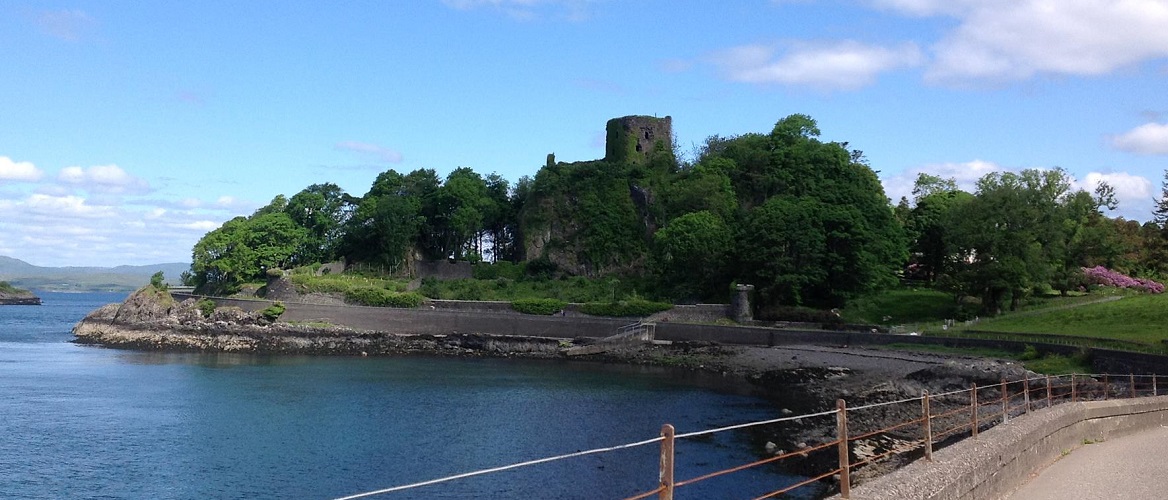Born near the Little Bay
Oban OH-bən; not oh-BAN which a lot of people pronounce it as. An t-Òban in Scottish Gaelic meaning The Little Bay, is a town in Argyll and Bute. Despite its’ small size, it is the largest town between Helensburgh and Fort William. During the tourist season, the town can hold an extra 25,000 people from the live in population of almost 9000. The bay is an almost perfect horseshoe, protected by the island of Kerrera and the Isle of Mull. To the north is the long low island of Lismore and the mountains of Morvern and Ardgour, once Maclean lands, some still are. The site where Oban now stands has been used by humans since mesolithic times, as evidenced by archaeological remains of cave dwellers found in the town. Drive along the esplanade right to the end and follow the road right, you will see Dunollie Castle, a fortified site since the Bronze Age. This is a Clan Macdougal castle. The castle is open to the public as part of the Dunollie Museum, Castle and Grounds. Irish annals record that “Dun Ollaigh” was attacked or burned down three times, in 686, 698, and in 701. It was rebuilt in 714 by Selbach mac Ferchair (died 730), the King of Dál Riata destroyed it in 701. Excavations in the ‘70s suggest that this early fortification was abandoned some time in the 10th century.
The area around Dunollie became part of the semi-independent Kingdom of the Isles, ruled over by Somerled in the 12th century. On his death the MacDougalls became Lords of Lorne. Dougall, Somerled’s son, held most of Argyll and also the islands of Mull, Lismore, Jura, Tiree, Coll and many others in the 12th century. The builder may have been Dougall, or his son Duncan. Ewan MacDougall, great-grandson of Somerled and the third chief of the MacDougalls, switched the clan’s allegiance in the mid 13th century: initially allied with Haakon IV of Norway, from the 1250s Ewan remained loyal to the kings of Scotland. In the 14th century Ewan’s grandson John MacDougall, along with his kinsmen the Comyns (another story for another day), sided with the Balliols against Robert the Bruce. John MacDougall’s army defeated the Bruce at the Battle of Dalrigh in 1306, but Bruce returned in 1308 and crushed the MacDougalls at the Battle of the Pass of Brander. The MacDougall lands of Lorne were subsequently forfeit and were given to the Campbells, though Dunollie and other estates were regained later in the 14th century. The existing castle ruins date largely from the 15th century. The Marquis of Argyll (Campbell) captured the castle in 1644, but it was returned to the MacDougalls in 1661. In 1746, the MacDougalls abandoned Dunollie Castle and built Dunollie House just downhill from the castle ruins.
Prior to the 19th century, the town supported very few households, only minor fishing, trading, shipbuilding and quarrying industries, and a few tourists. The Renfrew trading company established a storehouse there in about 1714 as a local outlet for its merchandise, a Custom-house was not deemed necessary until 1736 when “Oban being reckoned a proper place for clearing out vessels for the herring fishery”. Believe it or no, Oban grew up around the distillery, founded there in 1794. The town was raised to a burgh of barony in 1811 by royal charter. Sir Walter Scott visited in 1814, the year in which he published his poem The Lord of the Isles; interest in the poem brought many new visitors to the town. The Lord of the Isles is a rhymed, romantic, narrative-poem by Sir Walter Scott, written in 1815. The story begins during the time when Robert Bruce, had been hunted out of Scotland by the English. Bruce returns over sea from the Island of Rachrin (Rathlin Northern Ireland?) but is forced to land close to hostile forces at Artonish Castle on the coast of Argylshire. Seeking refuge from tempestuous seas, Bruce begs shelter from Ronald, Lord of the Isles: inadvertently on the day of his marriage feast to the beautiful Edith of Lorn.
Oban was made a parliamentary burgh in 1833. A rail link – the Callander and Oban Railway – was authorised in 1864 but took years to reach the town. The final stretch of track to Oban opened on 30 June 1880. This brought further prosperity, revitalising local industry and giving new energy to tourism. Work on McCaig’s Tower, a prominent local landmark up on the hill, looking for all reasons like something the Greeks or Romans left behind, started in 1895. It was paid for by John Stewart McCaig (1824-1902) and was constructed, to give work for local stone masons. However, its’ construction ceased in 1902 on the death of its benefactor. Locals say it was built as a gift to his wife. As the seafood capital of Scotland Oban boasts a variety of seafood restaurants. The farmland in Argyll supports sheep and beef farming – with wild venison and game to keep carnivores happy, plenty of seafood landed and local shellfish goes by lorries travelling to Spain. The first Seafood Festival was held in Oban in 1995 – local hotels and restaurants introduced more shellfish onto their menus. Coordinated by the Scottish Association of Marine Science (part of the University of the Highlands) a bi-annual seafood festival now has a ‘Fringe Festival’ with music in local pubs and restaurants. During World War II, Oban was used by Merchant and Royal Navy ships and was an important base in the Battle of the Atlantic. The Royal Navy had a signal station near Ganavan, and an anti-submarine indicator loop station, which detected any surface or submarine vessels between Oban, Mull and Lismore. There was a controlled minefield in the Sound of Kerrera. The Royal Air Force had a flying boat base at Ganavan and on Kerrera, and the airfield at North Connel. A sector operations room was built near the airfield; after the war, this was extended to become the Royal Observer Corps Group HQ. Oban was also important during the Cold War because the first Transatlantic Telephone Cable came ashore at Gallanach Bay. This was a hot line between the US and USSR presidents. At North Connel, next to the airfield/airport was the NRC (Nuclear Reporting Cell) of the Royal Observer Corps (29 October 1925 to 31 December 1995).
Nowadays Oban is an important ferry port, CalMac – Caledonian McBrayne – ferries to many of the islands of the Inner and Outer Hebrides including Castlebay, Coll, Colonsay, Craignure, Kennacraig, Lismore, Lochboisdale and Tiree. Through our travels as tour operators, especially with fellow Maclean’s we have been to all of these destinations. Myself (Paul McLean) being born just doon the road at Connel sure helps me soak up an interest in this whole area. https://mcleanscotland.com/connel-west-coast-scotland Many of our tours stay or travel through Oban every year, you can too! Drop us a line.

